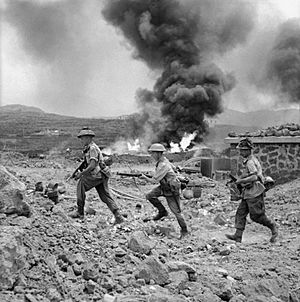Operation Corkscrew facts for kids
Quick facts for kids Operation Corkscrew |
|||||||
|---|---|---|---|---|---|---|---|
| Part of the Battle of the Mediterranean & the Allied invasion of Sicily | |||||||
 Men of the 1st Battalion, Duke of Wellington's Regiment, part of the 3rd Brigade of the British 1st Division, advancing inland during Operation Corkscrew. |
|||||||
|
|||||||
| Belligerents | |||||||
| Commanders and leaders | |||||||
| Strength | |||||||
| 14,000 | 12,000 | ||||||
| Casualties and losses | |||||||
| 15 aircraft shot down | 40 killed 150 wounded 11,000 prisoners |
||||||
Operation Corkscrew was the secret name for a military attack by the Allied forces on the Italian island of Pantelleria. This island is located between Sicily and Tunisia. The attack happened on June 11, 1943, during Second World War. It took place just before the bigger Allied invasion of Sicily.
There was an earlier plan in 1940 to take Pantelleria, called Operation Workshop. However, that plan was stopped. This was because the German air force, known as the Luftwaffe, made the Axis air power in the area much stronger.
Why was Pantelleria Important?
The Allies started focusing on Pantelleria again in early 1943. The island had important radar stations and an airfield. These facilities were a big threat to the planned invasion of Sicily, which was code-named Operation Husky.
The Italian army on Pantelleria had about 12,000 soldiers. They were well-protected in strong pillboxes and 21 different gun batteries. These batteries had various types of cannons.
The Allies also wanted to see how well heavy bombing could damage strong defenses. They decided to try and force the island to surrender using only air and naval attacks. If that didn't work, they planned an amphibious invasion for June 11.
The Attacks and Landings
Starting in late May, the island was bombed more and more often. In early June, the attacks became very intense. Over 14,000 bombs, weighing more than 4,000 tons, were dropped on 112 Italian gun positions.
On June 8, the Royal Navy sent a group of ships. This group included five cruisers, eight destroyers, and three torpedo boats. They fired their guns at the main port on the island.
Important leaders watched this attack. These included General Dwight D. Eisenhower, who was the top Allied commander in the Mediterranean. Admiral Andrew Cunningham also watched from the main ship, HMS Aurora. From May 8 to June 11, Allied planes flew 5,285 missions. They dropped over 6,200 tons of bombs on the island.
The Allies demanded that the Italian soldiers surrender twice, but they received no answer. So, on June 11, the sea invasion began. About an hour before the landing boats reached the beaches, the Allied ships started firing their guns.
What the attackers didn't know was that the Italian commander, Admiral Gino Pavesi, had asked Rome for permission to surrender the night before. He received permission that very morning. When the first British Commandos landed, the Italians had already given up. This meant no fighting was needed.
What Happened Next?
The intense ten-day air bombing greatly weakened the Italian gun positions. Their effectiveness was reduced by 47%. Out of 112 guns that were bombed, two were hit directly. Seventeen were hit very close by, and 34 were damaged by flying debris and splinters. Ten of these were damaged beyond repair. All communication systems were destroyed, along with many gun positions and ammunition storage areas.
The Italian soldiers on other nearby islands, like Lampedusa and Linosa, also surrendered quickly in the next few days. Operation Corkscrew cleared the way for the bigger invasion of Sicily, which happened a month later.

